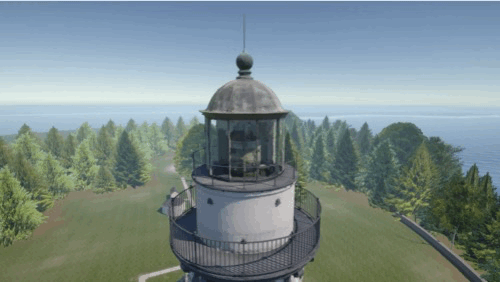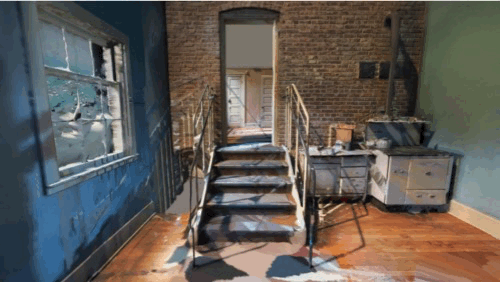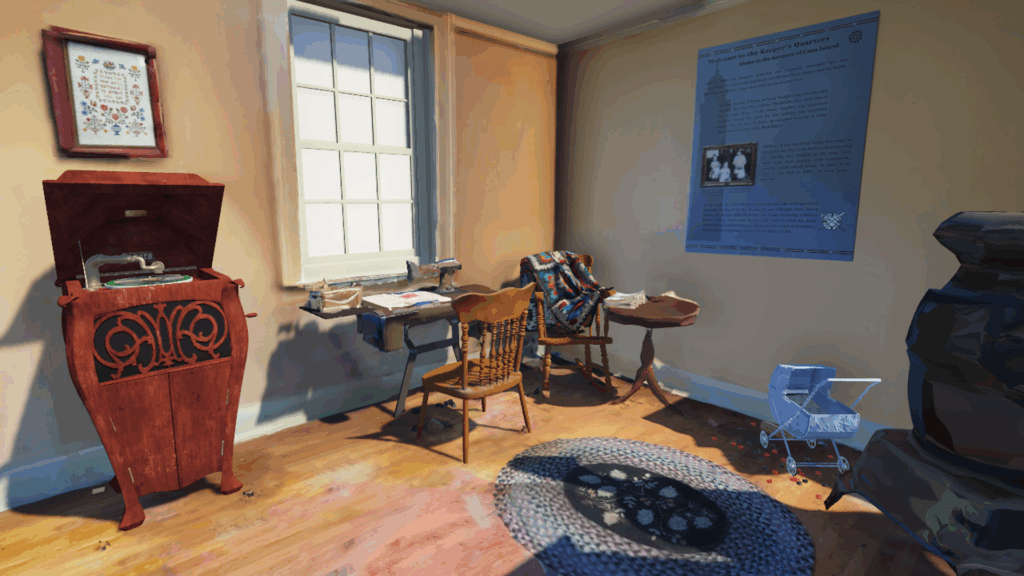A view from the top of the Cana Island Lighthouse
Most visitors to Cana Island Lighthouse face a choice: climb the 97 steep steps to the top, or stay below and imagine the view.
08/06/25
Most visitors to Cana Island Lighthouse face a choice: climb the 97 steep steps to the top, or stay below and imagine the view.
08/06/25
A simulated sunset as the virtual lighthouse stands sentinel beside its historic keeper’s house.
Most visitors to Cana Island Lighthouse face a choice: climb the 97 steep steps to the top, or stay below and imagine the view.
For some, it’s not really a choice at all.
“There are people who can’t make it up the 97 steps,” said Amber Samdahl, PBS Wisconsin’s director of design and innovation. “How can we give them a comparable experience?”
This question sparked PBS Wisconsin’s Illuminating Cana Island, a virtual tour that invites anyone to explore the historic lighthouse from a web browser. But designing a digital experience that captures the magic of being there posed challenges that pushed the team into uncharted territory.

An early render of the lighthouse and the surrounding Cana Island.
The idea grew from PBS Wisconsin’s earlier success with immersive storytelling. Samdahl explained that their previous project — Shipwrecks! — proved they could “take people to places most of us cannot go.” That project employed virtual reality headsets, which were an obstacle for some of the audience engaging with Shipwrecks! For their next project, the team wanted to try something with wider accessibility and reach.
Lighthouses emerged as a subject with potential for “scrollytelling,” inspired by projects like the Washington Post’s interactive tour of New York City’s Tenement Museum. Scrollytelling is driven by simple interaction familiar to any web user — using basic scrolling, arrows and mouse clicks.
“Cana Island was one of the first lighthouses that came to mind,” said interactive media producer Angelina Shi, who led the project’s visual development and historical research. “You really can’t talk about Wisconsin lighthouses without mentioning Cana Island.”
Creating an immersive tour of a historic lighthouse required solving design and development problems brand new to the team. The first challenge: how do you capture a 150-year-old building in three dimensions?
Enter TechRender, a Milwaukee-based company specializing in historic architecture, using cameras capable of capturing light, color and depth simultaneously. “It’s essentially shooting a laser while spinning around, capturing millions of data points,” Shi said. The device creates a “point cloud” which can be converted into a 3D model and manipulated in Unity, a video game development environment.

A “point cloud” created from the scan of the lighthouse performed by TechRender, which was then converted into a 3D model.
The 3D model needed some slight renovation to resemble the lighthouse as it appears in real life. Shi and colleagues spent time remodeling furniture and objects that didn’t scan well, including the Victorian-era Victrola which virtual explorers can interact with to change the songs playing in the lighthouse. Everything was recreated from photos taken on-site to maintain historical accuracy.

An early render of the keeper’s living quarters in the Cana Island lighthouse.
At this point, the team had a high-resolution 3D model of the Cana Island Lighthouse — essentially a fully navigable environment, like a level in a video game. But instead of designing an open-world experience where you roam the island like a Fortnite character (yes, PBS Wisconsin technically has the assets to do that!) the team chose a more guided approach. Using the game engine’s tools for lighting and camera control, they crafted a virtual tour that moves viewers through the space purposefully. Visitors can move through the front door, explore each room along a curated path and ultimately ascend the steps to the Fresnel lens at the top of the lighthouse.

A simulation of sunset on Cana Island, from the Unity game engine where the experience was crafted.
Scrolling up and down in Cana Island is much less complex than most video games, and this ease accommodates powerful storytelling, according to Matt Barnes, the web developer on the project.
“Scrolling is just such a natural and intuitive gesture on the web, especially in the age of smart phones and tablets,” Barnes said. “We didn’t have to teach anybody how to navigate this experience.”
Different devices scroll differently, but Barnes found solutions with some experimentation.
When you move through the lighthouse, what you’re technically scrolling through are the timestamps of the video that guide you through the space, explained Barnes. Your scroll direction and speed are the equivalent to fast-forward, rewind, play and pause on a TV remote.
“It was unintuitive because the whole point of the experience is that you can go at your own pace and the video time doesn’t really matter,” he explained. “But that timestamp just turned out to be the most stable thing upon which to base everything else.”

An early render of the trip up the stairs to the top of the Cana Island lighthouse.
With the building built and the plan for visitors in motion, the team faced a fundamental question: how much history is too much? Shi had combed through pages and pages of digitized lighthouse keeper logs from the Door County Maritime Museum, uncovering perfect little moments in time — a story of a lighthouse keeper’s pet deer, mundane weather observations and countless other human details —that brought the lighthouse’s past to life.
To keep from overwhelming users, many of these hidden gems have been made into optional “points of interest,” allowing users to make their way through the core of the experience quickly, but rewarding those who poke around and explore.
“If someone just wants to read the bare basics, they can go through without clicking anything,” Shi explained. “If someone is interested in doing a deeper dive, they have these other things they can read about.”
The Victorian-era Victrola became the perfect test case — something the team saw in the actual lighthouse that visitors can’t normally interact with. Thanks to some technical innovation, it became a favorite aspect of the experience, featuring period-accurate music from the era of the 1920s when the lighthouse was operational.
“We were able to play with the volume and stereo image as you walk around the lighthouse so that it gets louder as you move toward the record player and quieter as you move away from it,” Barnes said. “The day we got that working was probably my favorite day on the whole project.”
Samdahl agreed the audio transformed the experience. “That kind of detail really sets the tone and immerses you at a new level.”

Spatial audio linked to the Victrola in the lighthouse’s living space became a highlight both for test users and for the team working on the experience.
The lighthouse project represents more than technical achievement—it embodies PBS Wisconsin’s mission of accessibility and education. As Samdahl explained, innovation is a core value rooted in public media’s history, but the current moment requires new approaches to storytelling. “People that grew up with video games are now in their 50s…it’s a huge audience to tap into [with] interactive content.”
The broader goal, according to Samdahl, is creating content where people become the protagonist of their own stories, choosing how they want to learn and what interests them. Research supports this approach — interactive media leads to better memory recall and learning outcomes, particularly valuable for a mission-based organization focused on education.
“Interactive media is a great avenue for empathy,” Samdahl said. “Immersive experiences enhance memory recall and deepen engagement, creating more meaningful connections. When you’re invited to see the world through someone else’s eyes, it opens up opportunities for greater understanding.”
The project was also an excellent opportunity for collaboration — both between different PBS Wisconsin departments and with outside partners. Early prototype development even involved University of Wisconsin-Madison computer science students through a capstone course.
The project’s success has generated interest beyond its original scope. Both the Door County Historical Society and Wisconsin Maritime Museum have reached out about creating similar experiences for their lighthouses, said Samdahl. Shi’s work spearheading the project has also earned her some well-deserved personal accolades — she was recently named a 2025 Rising Star by Current.
For a public media organization committed to telling stories that create empathy for people different from ourselves, the lighthouse project proves that innovation, connection and accessibility can all illuminate each other. The virtual tour ensures that everyone can climb those 97 steps to the top of Cana Island Lighthouse.
For more interactive experiences from PBS Wisconsin, visit our interactive media hub.
What do you think?
I would love to get your thoughts, suggestions, and questions in the comments below. Thanks for sharing!
Mark Riechers
The author has turned off comments for this article.